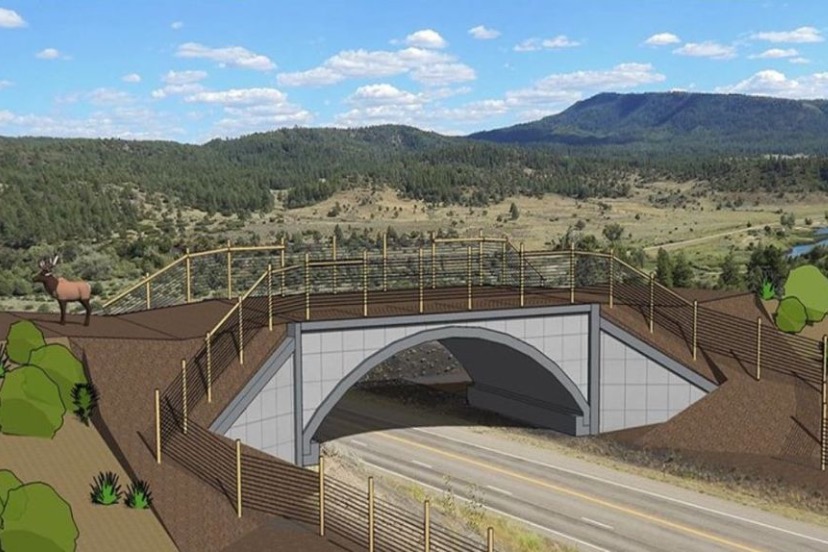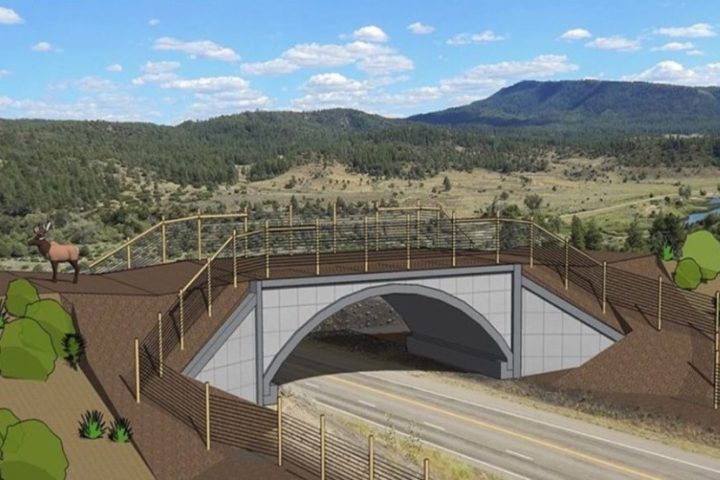Colorado Parks and Wildlife and the Colorado Department of Transportation have partnered with the Southern Ute Indian tribe and several other organizations to construct a new wildlife mitigation project in southwest Colorado. The project, slated to begin this coming spring, will construct several features on U.S. Highway 160 between Durango and Pagosa Springs — including a wildlife overpass and a wildlife underpass — that will promote safer travel for motorists, enhance safer movement of wildlife, and reduce animal-vehicle collisions along this section of highway. Studies indicate that various species of wildlife prefer either above ground or underground routes to cross highways.
The project site is located on U.S. 160 in Archuleta County, centered at the CO Highway 151 intersection, near Lake Capote and Chimney Rock National Monument. The project will span for approximately two miles on U.S. 160, about 13 miles west of Pagosa Springs and 37 miles east of Durango, between mile points 126-128.
The location of the project will bring a great improvement for that section of highway, explained Scott Wait, senior aquatic biologist for Colorado Parks and Wildlife.
“This is a heavily used corridor by vehicles and an important area in the San Juan Basin for big game,” Wait said. “Deer and elk spend the warm months in the high country to the north; but most big game move to the important winter range areas south of the highway during the winter. So there is a huge number of deer and elk that cross the highway at that location.”
Work will include:
- Construction of a wildlife underpass structure just west of the U.S. 160 and CO 151 intersection at MP 126.8
- Construction of a wildlife overpass structure just east of the U.S. 160 and CO 151 intersection at MP 127.3
- Installation of an 8-foot-tall exclusion fence along both sides of U.S. 160 throughout the project limits, approximately a two-mile stretch from MP 126 – 128
- Construction of earthen escape ramps and deer guards along the length of fencing
- Installation of a large deer guard on CO 151 at the approach to U.S. 160, similar to a cattle guard but much wider to prevent deer from jumping across and into the highway corridor
- Extension of the existing westbound passing lane on U.S. 160 at the CO 151 intersection
- Extension of the westbound left-turn acceleration lane on U.S. 160 at the CO 151 intersection
The construction project, awarded to Ralph L. Wadsworth Construction Co. of Utah for $7.95 million, will be completed within one construction season, breaking ground next spring and wrapping up by the fall of 2021. The total cost of the project is approximately $11.3 million, including design and planning.
This is an extraordinary collaborative project, CDOT officials said.
“We are extremely grateful for the phenomenal partnerships that have made this project feasible,” said Tony Cady, CDOT Planning and Environmental Manager for southwest Colorado. “These partnerships greatly leverage the individual contributions made by these different entities and will increase the return on our investments.”
The Southern Ute Indian Tribe is a critical partner and provided important biological information to help design the project.
“Hunting is an extremely important component to the Southern Ute Indian Tribe and culture and it is considered vital to keep these traditions alive,” said Steve Whiteman, acting director of Natural Resources. “The Tribe has long maintained a positive working relationship with the state of Colorado, and looks forward to the collaboration with CPW and CDOT to bring this important project into reality.”
Organizations and agencies as well as their contributions toward the project include:
- $8.6 million from CDOT
- $1.3 million from the Southern Ute Indian Tribe
- $750,000 from CPW
- $317,000 from the National Fish and Wildlife Foundation
- $100,000 from Mule Deer Foundation (via a private donor)
- $75,000 from the Rocky Mountain Elk Foundation
Cady added, “Not only have several agencies and organizations come forward with valuable funding commitments, some agencies have also contributed with studies, research and development plans to make the project possible.”
More than 60% of all crashes in the project area are attributed to wildlife-vehicle collisions. Without treatment, these numbers are expected to grow as wildlife-vehicle crashes continue to show an increasing trend since 2012. The project’s wildlife mitigation features will greatly enhance the safety of this highway corridor for both motorists and wild animals and are expected to reduce those wildlife-vehicle collisions by at least 85%.
The Colorado Wildlife and Transportation Alliance, a consortium of federal and state agencies, academics, nonprofits, biologists, and engineers, played a significant role in developing the unique financial partnerships to advance the southwest Colorado project. Additionally, along with their financial backing, the Southern Ute Tribe provided support with critical Global Positioning System data which identified seasonal migration patterns and habitat in the area.
CDOT has built more than 60 wildlife mitigation structures crossing above or under highways throughout the state. Additionally, almost 400 miles of high big game fencing has been installed along state and U.S. highways or next to the interstates.


